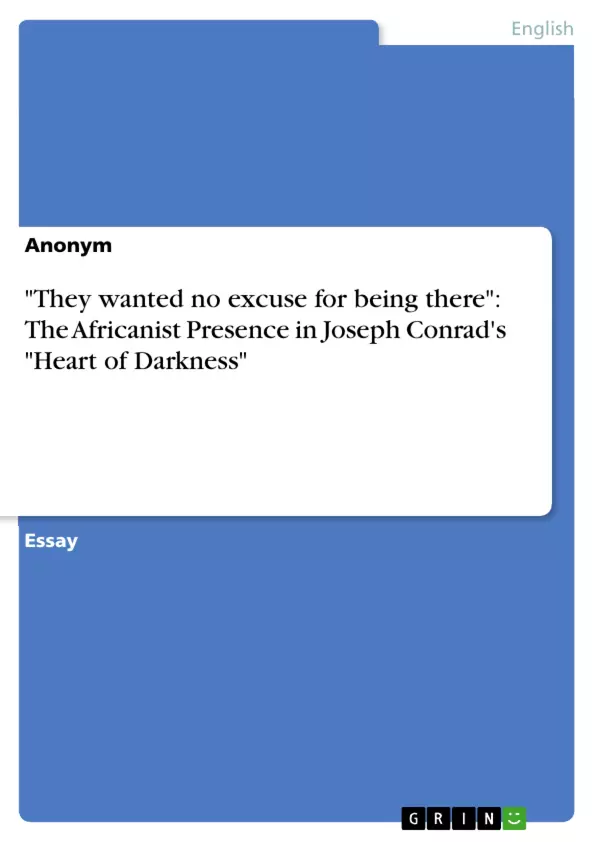When Joseph Conrad published Heart of Darkness in 1899, he was probably not expecting that this story keeps so many critics busy for so many years, even after his death in 1924. A huge wave of critics and also defending scholarly journals and books occurred after 1975. In this year the Nigerian novelist Chinua Achebe accused Conrad of being a racist who portrays such a poor image of Africa as it can be seen as “the antithesis of Europe and therefore of civilization, a place where man’s vaunted intelligence and refinement are finally mocked by triumphant bestiality” (Achebe). This triggered a wave of indignation and authors like Hunt Hawkins, Cedric Watts and Patrick Brantlinger who defended Conrad’s work as a critic on imperialism in which Conrad presents the dreadful reality of colonialism in the Congo at a time in which xenophobia was the most popular understanding of racial differences. But as many authors have already recognized, the derogatory language, the focus on the outward appearance of blacks, and the use of confusing and definitely pejorative adjectives leaves an image of Africa that “can hardly be called flattering” (Hawkins).
Unlike Chinua Achebe, who concentrated his critic on one specific work, Toni Morrison’s critic in Playing in the Dark: Whiteness and the Literary Imagination (1992) was addressed to many authors who included a real or fabricated Africanist presence in their work as a catalyst in the formation of American identity (cf. Morrison). Since it seems that nobody has aligned the representation of the black race in Heart of Darkness with Toni Morrison’s work, I am trying to demonstrate that the Africanist presence was necessary for Joseph Conrad in order to hide his critical imperial stance in a way that it remains readable for the Victorian British audience. Since so many authors have already agreed to read Heart of Darkness as a critic on imperialism, I will not focus on demonstrating this critical stance. This is why I will analyze one paragraph in order to show how the racial superiority is conveyed in the story by constructing racial hierarchies before the general depictions of race in the Victorian British society is presented. In the end, I am trying to find signs of an Africanist presence, how Morrison defines it, in the story of Joseph Conrad and their impact on the protagonist and Kurtz.
Inhaltsverzeichnis (Table of Contents)
- Introduction
- The Construction of Racial Hierarchies in Joseph Conrad's Heart of Darkness
Zielsetzung und Themenschwerpunkte (Objectives and Key Themes)
The primary objective of this essay is to examine the Africanist presence in Joseph Conrad's Heart of Darkness and its significance in constructing racial hierarchies. The analysis focuses on a specific passage within the text to illustrate how the narrator, Charlie Marlow, portrays the Africans as a homogenous and dehumanized group, contrasting them with the individualistic and refined Europeans.
- The construction of racial hierarchies within the text.
- The role of the Africanist presence in shaping the narrative.
- The influence of Victorian imperialist perspectives on the portrayal of Africa and its people.
- The analysis of Marlow's narrative voice and its unreliable nature.
- The examination of Conrad's use of language and imagery to convey racial prejudice.
Zusammenfassung der Kapitel (Chapter Summaries)
- Introduction: This section sets the context for the analysis by discussing the ongoing debate surrounding Conrad's portrayal of Africa and its people. It highlights the critical reception of Heart of Darkness, particularly the accusations of racism leveled against Conrad. The introduction also introduces the author's intention to explore the Africanist presence in the text and its impact on the narrative.
- The Construction of Racial Hierarchies in Joseph Conrad's Heart of Darkness: This chapter delves into a specific scene in the novel where Marlow encounters a group of Africans who are visibly suffering under forced labor. The analysis focuses on the linguistic and narrative techniques employed by Conrad to convey the racial superiority of the Europeans over the Africans. It examines how Marlow's narration depicts the Africans as a homogenous and dehumanized group, emphasizing their physical appearance and reducing their humanity to a state of "bestiality."
Schlüsselwörter (Keywords)
This analysis focuses on the themes of race, colonialism, and imperialism in Joseph Conrad's Heart of Darkness. It examines how Conrad constructs racial hierarchies and explores the significance of the Africanist presence in shaping the narrative and influencing the reader's perception of the characters and their actions. Key concepts include racial discourse, narrative focalization, and the representation of the Other in literature.
- Quote paper
- Anonym (Author), 2022, "They wanted no excuse for being there": The Africanist Presence in Joseph Conrad's "Heart of Darkness", Munich, GRIN Verlag, https://www.hausarbeiten.de/document/1187833


